Science Made Simple
Science made simple isn't rocket science. But it can ignite an inquisitive mind and there are lots of very simple, playful experiments that will amaze, fascinate and and help your children learn some basic science fundamentals.
I spy Tea – Colleen Megarry
A fun activity for a child to discover the changes to clear water by adding one or more teabags.
Learning Intentions
Children can use their senses to observe changes in water by adding a tea bag to look-warm water and then to cold water. Differences can also be compared.
Resources
Small tray, bowl or basin, water, tea bags, tea cups
Activity
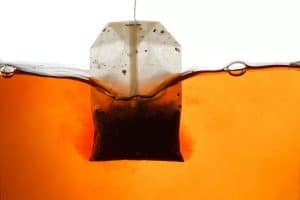 1. Using a small container with look-warm water (be aware of safety) the child can drop in a tea bag to investigate how the clear water changes.
1. Using a small container with look-warm water (be aware of safety) the child can drop in a tea bag to investigate how the clear water changes.
2. The adult should encourage discussion from the child by chatting to them and by asking them a small amount of questions e.g. “What do you think will happen to the water when a tea bag is added?” “What colour is the water now?” Is there a smell from the water? “What might happen if we add more than one tea bag to the water?”
3. Afterwards, the child could then be asked to predict what might happen if a tea bag is added to cold water? Then this experiment could be carried out and results could be compared by using both the warm and cold water.
4. Lastly if desired, the child could have a fun tea party by making cups of tea with the cold coloured water.
Ice Excavations Superhero Style – Jason McLean
The “naughty” Villains have taken either the fruits and vegetables OR (toys) and trapped them in ice. It is the Superhero’s job to help rescue them.
Learning Intentions
Begin to discover different ways to melt the ice. What is the fastest way to free the objects that the “naughty” Villains have frozen. Use and understand language related to the various properties of water : ice, liquid, solid, freezing, melting, etc.
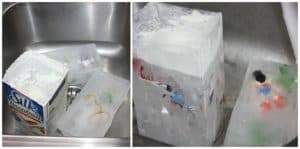 Required Resources
Required Resources
- Water
- Different shaped containers
- Fruit and vegetables/ Toys
- Warm and cold water
- A Large container (to melt the items in)
- Salt
- Pipettes/Jugs
Activity
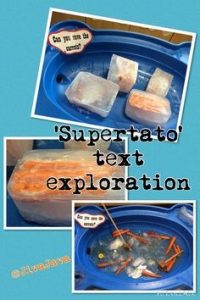 Freeze the fruit and vegetables/ toys into chunks of ice.
Freeze the fruit and vegetables/ toys into chunks of ice.- Let the children discover how to melt the ice fastest by dropping warm water and cold water onto the ice with a pipette/jug.
- The children could also take the ice outside and scrape it on the ground to break the ice.
- Discuss with your children how does the ice feel to start with, what is happening to it? Is it warm, cold, sticky?
Please note it is important to be careful with the salt as the children can get ice burns. It is best to use gloves to avoid this)
Extension
Record the results/time it takes and put them in order.
Rainbow Puddle Experiment! – Megan Morgan
On a rainy day there isn’t always much to do outside, so why not make a rainbow puddle to splash around in! This is a great way for children to see how colours combine and visualise the colours of the rainbow.
Learning Intentions:
To learn about what is in their world and how the natural world can change
To show curiosity about their environment
Activity:
1. Gather some things from your kitchen, you will need any kind of oil and some food colouring.
2. Put on your waterproof clothes and wellies ready to jump in some puddles!
3. Go outside and see if you can hunt for a stick to stir your puddle with. Alternatively, you can bring something from home to stir the puddle.
4. Search for a puddle that looks big enough to jump in!
5. Once you’ve found your puddle, add some oil in and stir it with your stick.
6. Next, add a few drops of food colouring, if you have more than one colour add a few drops of each.
7. Use your stick to give it a mix, or even better use your feet!
8. What colours can you see in your puddle?
Activity Extension:
Once you’ve finished splashing in your puddle, you can take a piece of paper and lie it on top of the puddle. The rainbow in the puddle should copy on to your page, you can take it home and dry it!
FLOAT AND SINK FUN – Lindelle McCrory
Have fun discovering objects which float and sink helping to further develop children’s senses.
Learning Intention
Explore and predict which objects will float and sink.
Resources
Basin/ container of water, peg, pencil, crayon, acorn, elastic band, bottle top, sponge, button, string and lemon. (You can let the child choose various objects from around the house).
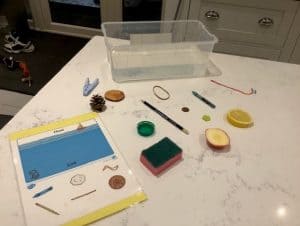 Activity
Activity
1. Firstly, the adult or child can half fill a basin of water.
2. Both the adult/child can gather objects around the home to investigate if they will float/sink.
3. Prior to putting the objects in the water, the adult can discuss with the child the various objects gathered allowing the child to feel and describe the object.
4. Next, allow the child to predict whether the object will float/sink before putting the object in the water.
5. Finally, at the end of the activity the adult can recap and discuss with the child the objects which did float/sink and why.
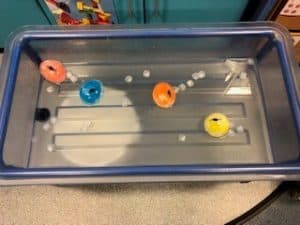 Penguin ice eggs – Amy Woods
Penguin ice eggs – Amy Woods
Your task is to help the baby penguins hatch from their ice eggs.
Learning Intentions
Children will begin to discover ways to melt ice. What is the fastest way to hatch the penguin from their eggs? Talk about the various properties of water, i.e. ice, water, liquid, melting, etc.
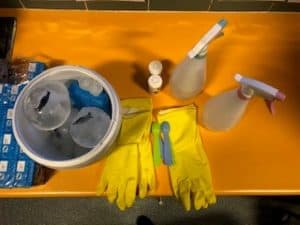 Activity
Activity
1. Put a small toy penguin (or other small toys) into a balloon. Fill the balloon with water and tie. (add food colouring into the balloon to make the eggs colourful).
2. Put the balloon in the freezer and allow it to freeze. Once frozen, peel of the balloon and place the ice eggs into a tray.
3. Encourage the children to help the penguins hatch from their eggs using a variety of methods. For example, pouring salt, spraying warm water from a spray bottle, using syringes, etc. N.B. if using salt, ensure to wear gloves to protect hands from ice burns.
How far can your rocket go? – Kerry O’Kane
Make a rocket and use your breath to shoot it across the room. Compete to see who can land on the moon! Use a measuring tape to measure your distance and record the results.
Learning Intentions
Measure distances using a measuring tape and predict how far your rocket will go.
Activity
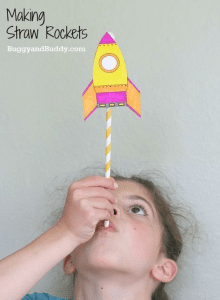 1. Resources: Straw, tape, colouring pencils/pens, scissors, circles to create planets and a measuring tape
1. Resources: Straw, tape, colouring pencils/pens, scissors, circles to create planets and a measuring tape
2. Use the resources to create your own rocket and launcher.
3. Make planets and a moon and lay them out on the floor.
4. Predict what planet you want to land on and use your strength to blow the rocket off the straw.
5. Use the measuring tape to record the distance.
6. Extension – record results and put in order.
Changes of Matter Chocolate Experiment – Selina Hendry
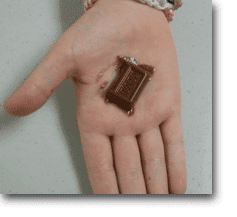 This tasty experiment uses chocolate as a visual representation of the change from solids to liquids. Can we do it again mum?
This tasty experiment uses chocolate as a visual representation of the change from solids to liquids. Can we do it again mum?
Learning Intentions
Children will develop an understanding of the process of change of matter, specifically the melting process of solids. Children will also explore methods and ways to speed up this process.
Activity
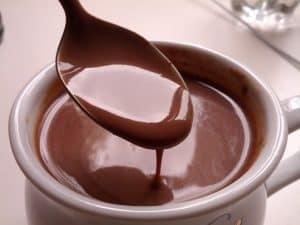 1. Experiment with how chocolate melts.
1. Experiment with how chocolate melts.
2. Place a chocolate button in the centre of their hand, close their hand tight and sing the alphabet. Then discuss what happened to the chocolate button. It melted, but why? (heat from our hand).
3. To extend the activity, use different safe heat sources to melt the button. Get them to predict how many seconds it will take and then time it.
4. Explore if white chocolate or dark chocolate melt faster or slower.
5. To conclude, discuss other ways to melt solids and what you could do to change a solid back to a liquid.
